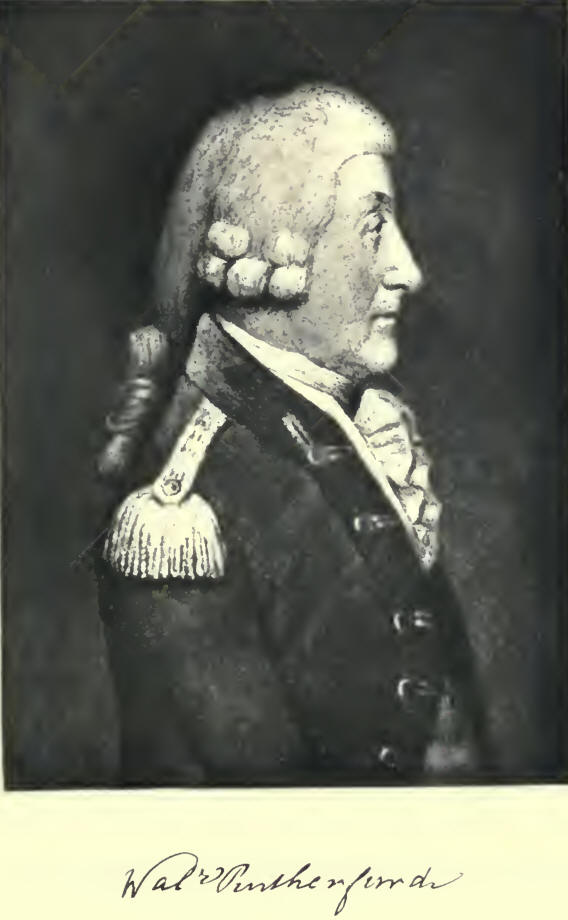|

Seventh President
1766-1767; 1792-1798.
Walter Rutherfurd was the
sixth son of Sir John Rutherfurd and Elizabeth Cairncross of Edgerston,
Roxboroughshire, Scotland, and of the eleventh generation from James
Rutherfurd, to whom the manorial lands of Edgerstone had been granted in
1492 by King James IV of Scotland.
He was born on the 29th
December, 1723. at Edgerstone, Scotland, and died on the 10th January,
1804, at his residence in the City of New York.
Entering the Royal Navy
at the early age of fifteen years, he served until 1746, when he left
the sea service to enter the army as an officer in the Royal Scots
Regiment, and was paymaster in the campaigns of Flanders and Germany. At
the outbreak of the French and Indian War in 1756 he sailed for this
country and immediately joined the Royal and Colonial forces as Captain
of Grenadiers in the Fourth Battalion of the Royal American Regiment.
In the course of his
military career he received the terms of surrender of Fort Niagara, and
when the City of Montreal capitulated, the keys of the city were
delivered to him. He subsequently became Judge Advocate and a Major in
the Colonial Army.
He retired from active
duty, however, in 1760, and about 1775 received a patent of five
thousand acres in New Jersey for his military services. He also acquired
a large landed property by marriage. Owing to his early education and
training, and his family affiliations, his sympathy was naturally with
the royal cause, and though he took no active part in the dispute and
subsequent warfare, he was prudent enough to retire to his estate in New
Jersey for this period.
After peace was declared,
however, he returned to New York, and entered into the business of
importing. He had extensive commercial interests with England at this
time and ranked among the wealthiest of his fellow-citizens. In 1771 he
was an incorporator of the New York Hospital, of which he acted as
Governor from 1774-1778. He also owned a share of the Tontine Coffee
House in 1796, and named as the successive owner of this share Robert
Rutherfurd, son of John Rutherfurd, Esq., of the State of New Jersey,
and Helena, his wife. He was also President of the Agricultural Society,
and a founder of the Society Library.
True to his Scottish
birth and traditions, he was one of the founders and original members of
Saint Andrew’s Society, having been elected on the 19th November, 1756.
Later he served as an Assistant from 1761-1766; as First Vice-President
from 1785-1787; and as President from 1766-1767 and 1792-1798.
As early as 1798 he
resided at No. 1 St. George’s Street (Broadway, above St. Paul’s Church,
where the Astor House now stands), and in 1803 was residing at No. 219
Broadway, doubtless the same place under new numbering.
Much of the data
concerning him is learned from his will, dated the 18th April, 1801, and
proved and recorded on the 18th January, 1804, in the New York County
Surrogate’s Office, in which he calls himself “son of Sir John
Rutherfurd of Roxboroughshire, North Britain, being in the 78th year of
my age.” He leaves his wife, Catherine, all his estate, real and
personal if living at his death, but if dead, then a portion of his
estate is to go to “Major-General Matthew Clarkson, the father of my
granddaughter, Mary Rutherfurd Clarkson,” viz.: the land in Vesey
Street, now occupied by Dr. James Clark, and six thousand dollars to be
held by said Major-General Clarkson in trust for his granddaughter until
she reaches twenty-five years of age and then to be distributed to her.
But if his granddaughter does not survive or is married against the will
of her father, then two-thirds of the above property is to be
distributed to the children of Matthew Clarkson by his present wife, and
one-third to John Rutherfurd, the uncle of his said granddaughter. He
gives to his grandson, Robert Walter Rutherfurd, his watch and seal and
his share in the Tontine Coffee House; to his nephew, John Rutherfurd of
Edgerton, son of “my eldest brother John,” and to his nephew, John
Rutherfurd of Messburnford, a gold ring each. He gives to his son, John
Rutherfurd, the rest of his lands and personal property. The witnesses
to his will were Cadwallader D. Colden, Charles Graham and Edward W.
Laight.
He married, the 21st
December, 1758, Catherine Alexander, daughter of James Alexander and
Mary Provost, his wife being a sister of General William Alexander, the
so-called Earl of Stirling, and had issue: (1) John Rutherfurd, born
1760; (2) a daughter, who married Major-General Matthew Clarkson.
His portrait is
reproduced from a painting now in the possession of his lineal
descendant, William Walton Rutherfurd, and represents him in the uniform
of a Captain in the Royal American Regiment. |
